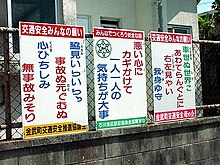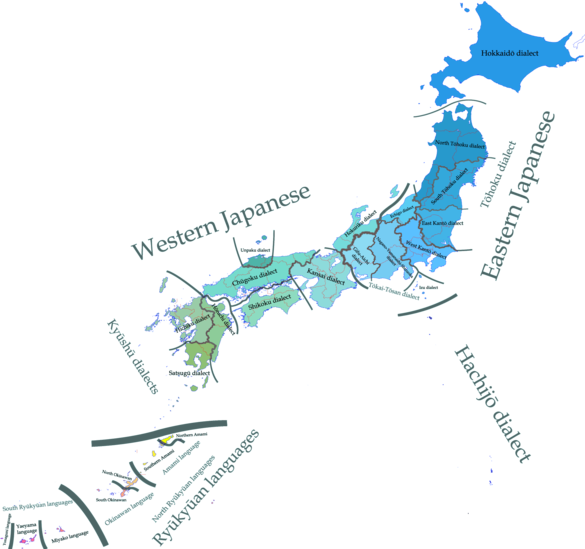Ryūkyū languages
| Ryūkyū languages 琉球 語 ryūkyūgo (Japanese) 島 言葉 shimakotoba (ryukyu) |
||
|---|---|---|
|
Spoken in |
Ryūkyū Islands |
|
| speaker | about 1 million | |
| Linguistic classification |
|
|
| Language codes | ||
| ISO 639 -1 |
Yes |
|
| ISO 639 -2 |
jpn |
|
| ISO 639-3 |
jpn |
|
The Ryūkyū languages ( Japanese 琉球 語 , kana り ゅ う き ゅ う ご ryūkyūgo ; ryukyu 島 言葉 , kana し ま こ と ば shimakotoba ) are a subgroup of the Japanese Ryūkyū language family . This minority languages are on to Japan belonging Ryukyu Islands spoken in the south of Japan.
Emergence
The Ryūkyū languages, together with the Japanese language, form the Japanese or Japanese Ryūkyū language family.
Japanese and the Ryūkyū languages separated about 2000 years ago and subsequently developed largely independently of one another. It is believed that the Ryūkyū peoples split off directly from the original Japanese population and populated the Ryūkyū Islands and parts of the southern Kyūshū.
The further genetic affiliation of the Japanese-Ryūkyū language family is unclear. Theories of genetic relationship exist with Korean , the Austronesian languages , the Tai-Kadai languages , the Austro-Asian languages, and the Altaic languages ; the existence of an Austronesian substratum is discussed , which is primarily justified phonologically and lexically .
Current situation
Due to the spread of the Japanese standard language after the Meiji Restoration and the subsequent annexation of the Kingdom of Ryūkyū by Japan, all Ryūkyū languages are now threatened with extinction. Although the number of speakers is given as one million, the truthfulness in view of the current level of use is highly questionable. While the members of the older generation usually speak fluent Japanese alongside Japanese, the younger ones (most of whom move to the big cities of the Japanese main islands and therefore do not need their "dialect") mostly only speak Japanese and at best have passive knowledge of the Ryūkyū languages .
In the last ten years, however, movements have emerged that campaign for their revitalization. However, these movements are currently not receiving any support from the Japanese state or the prefectural authorities of Okinawa and Kagoshima. The future of the Ryūkyū languages is therefore uncertain.
definition
There are considerable differences between the Ryūkyū languages and Japanese in terms of phonology , morphology , syntax, and the lexicon , some of which reflect ancient Japanese phenomena . The Ryūkyū languages are therefore of great importance to language historians, among others. Information on the number of Ryūkyū languages varies widely. They range from three to eleven languages. There are no modern linguistic standard varieties and no written language varieties either. This makes it difficult to distinguish them.
Five Ryūkyū languages can be identified on the basis of mutual intelligibility. These are from north to south: Amami-Oshima, Okinawa, Miyako, Yaeyama and Yonaguni. None of these languages allows mutual communication with Japanese. Studies of the basic vocabulary have shown that there is only a 59 percent agreement between the Tokyo variety and the Miyako variety. The share of the common, derivable basic vocabulary is therefore lower than that between German and English, for example. There are numerous local varieties within the Ryūkyū languages. The Okinawan Language Research Center has conducted phonological studies in more than 800 local dialects.
The northern languages, which are closer to the main islands, are more similar to modern Japanese, but there is a clear break between the northernmost Ryūkyū language (Amami) and the southernmost Japanese dialect (Kagoshima / Satsuma-ben). The oldest surviving source of a Ryūkyū language is the Omoro Sōshi , compiled in 1532 , a collection of traditional songs and rituals.
Some scholars see the Ryūkyū languages as "Okinawa dialects" of Japanese. The designation of a variety as a “dialect” is an expression of a power structure. This means that with regard to certain political goals, a certain variety is defined as the standard, that is, as the "language" ( 言語 , gengo ) of the elites within science, state institutions and the media, whereas others are pejoratively defined as "dialect" ( 方言 , hōgen , 弁 ben ). This leads to a self-reinforcing definition of the standard variety as “high-level language” and a self-reinforcing devaluation of the other varieties.
structure
-
Ryukyu ( 琉球 語 )
- Amami ( 奄 美 語 )
- Northern dialects : Tanegashima, Yakushima, Nördl. Oshima
- Southern dialects : Südl. Oshima, Yoron
- Okinawa ( 沖 縄 語 )
- Dialects: Kunigami (northern Okinawa), Ie, south-central Okinawa (standard Okinawa), main island dialect, Shimajiri ( affiliation disputed )
- Miyako ( 宮 古語 ) dialects : Miyako, Irabu
- Yaeyama ( 八 重 山 語 ), dialects: Ishigaki, Iriomote, Taketomi
- Yonaguni ( 与 那 国語 )
- Amami ( 奄 美 語 )
Comparison with the Japanese
The vowels of the Ryūkyū languages differ from those of Japanese. The following correspondences can be seen:
| Japanese | Ryūkyū languages |
|---|---|
| e | → i |
| O | → u |
| ai, ae | → e: |
| au, ao | → o: |
See also
literature
- Masayoshi Shibatani: The Languages of Japan . Cambridge University Press 1990.
- Martine Irma Robbeets: Is Japanese Related to Korean, Tungusic, Mongolic and Turkic? . Harrassowitz, Wiesbaden 2005. (The final answer to the question posed in the title after a nearly 1000-page investigation of all known material is an unequivocal "yes".)
- Ho-Min Son: The Korean Language. Cambridge University Press 1999. (Sohn also comes to the conclusion that the material available shows a genetic relationship between Japanese, Korean and the Altaic languages.)
Web links
- Ethnologue, Languages of the World: Ryukyuan
- The Ryukyuan Language - Phonetic Database (Japanese site with audio samples for the standard variety Shuri-Naha and the Nakijin, Amami and Miyako dialects)
- Basic Vocabulary: Amami
- Basic Vocabulary: Miyako
Individual evidence
- ↑ Handbook of the Ryukyuan Languages . January 31, 2015, doi : 10.1515 / 9781614511151 ( degruyter.com [accessed on July 27, 2018]).


